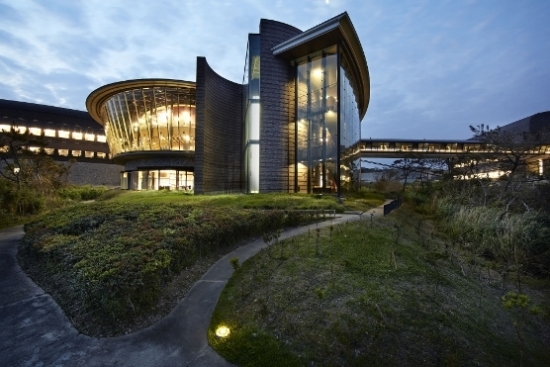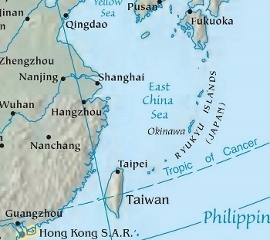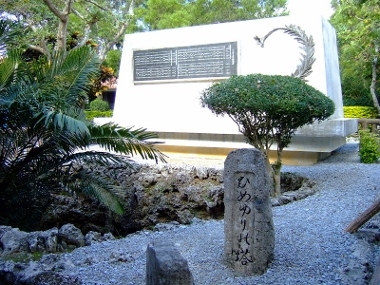Double Firsts at Japanese University
In the spring of 2015, at the conclusion of an organized group tour of Japan, we visited Okinawa, Japan.
Okinawa is the largest island of the Ryukyu Islands, a chain of Japanese islands that stretch southwest from Japan to Taiwan. It is 400 miles south of the main Japanese islands, and a two-hour flight from Tokyo. The main town, called Naha, is the capital of the Okinawa Prefecture, one of 47 prefectures in Japan. The population is approximately 1.5 million persons, most of them living on Okinawa Island which has an area of approximately 450 square miles. The climate is sub-tropical with a rainy season. The island is frequently visited by passing hurricanes and is also located on the earthquake-prone Ring of Fire of the Pacific Rim. The economy depends mainly on tourism and the contentious presence of large US military bases, and it is the "poorest" of Japanese prefectures.
Despite being of historical and cultural interest (including the fact that the population of the Okinawa islands has the largest proportion of centenarians in the world) our main reason for choosing to go to Okinawa was to visit our cousin, Professor Jonathan Dorfan, who is the President of OIST - The Okinawa Institute of Science and Technology Graduate University.
OIST was set up by the Japanese Government in order to boost research and development in Japan by sowing the seeds for an internationally recognized center of science and opening up Japan to international cooperation and innovation. OIST received accreditation on November 1, 2011, and began classes in September 2012.
And now the Jewish South African connection:
Nobel laureate, Dr. Sydney Brenner, was formally appointed as the inaugural president of OIST in August 2005, and helped to implement the ideas and principles on which the university was built.
Dr. Brenner was born in Germiston, South Africa - as it happens, my husband's hometown. His parents, Lena and Morris Brenner, were Jewish immigrants to South Africa. His father, a cobbler, came to South Africa from Lithuania in 1910, and his mother from Riga, Latvia, in 1922. Their second son, Yitzhak, is a geologist in Jerusalem.
In November 2011, our cousin, Dr. Jonathan Dorfan, was appointed President of the university. Jonathan was born in Cape Town, South Africa in 1947 to Archie and Esther Dorfan of Rondebosch, Cape Town. Archie, who had been living in Israel at the outbreak of WWII served in the British Army in Palestine and was commanding officer of many Sabra youths, some of whom were to become generals in the IDF.
Dr. Jonathan Dorfan received his B.Sc degree from the University of Cape Town in 1969 and his Ph.D. from the University of California, Irvine in 1976. He is the former director of The Stanford Linear Accelerator (SLAC 1999-2007). He was responsible for staffing OIST with a cadre of first rate faculty members from all over the world, attracting promising post-graduate students from Japan and abroad and completing the most ambitious building and equipping stage of a top rate facility.
OIST is an interdisciplinary graduate university where over half of the faculty and students are recruited from outside Japan, and all the teaching and research projects are conducted entirely in English. An interesting feature of the university is that it has no departments, and the absence of academic departments, the strong emphasis on shared/common research tools and the imaginative layout of the research space provide a natural home for truly interdisciplinary research.
OIST aims to be the best in the world, recruiting the best students and the finest teachers and researchers, with a 2:1 student to faculty ratio. The university also provides the most advanced, cutting-edge laboratories and equipment with easy access to the best instrumentation available to all researchers. In addition, the university is committed to equal opportunities and gender equality. All students accepted into the program are fully sponsored and financed by the Institute.
Our part of the world is represented at present by two members of staff – one Palestinian research professor from East Jerusalem, Professor Mukhles Sowwan, who earned his PhD in Material Engineering from the Hebrew University and who also has an appointment at Al Quds University on the West Bank. He is head of the Nanoparticles by Design Unit at OIST and when we met him he was most happy to speak to us in Hebrew as he doesn't get much chance to do that in Okinawa! The other staff member is an Israeli Doctor of Mathematics, and there are two graduate students, one fourth year student from the West Bank and one second year student from Israel.
The magnificent campus is built like a modern version of Okinawa's fortress, blending in with the landscape and at the same time allowing natural light to filter through the entire building. There is also a state-of-the-art Child Development Center, the brainchild of Renee Dorfan, Jonathan's wife, who, as a kindergarten teacher had many years of experience in a leading nursery school in Stanford, California. Children of students and the neighborhood are taught for half a day in English and the other half in Japanese. Many of these children have a third language at home, but amazingly this works perfectly!
In the West, Okinawa is most frequently associated with its part in WWII. In the Battle of Okinawa, American Army and Marine Corps troops fought a long and bloody battle to capture the island so that it could be used as the major air force and troop base for the planned invasion of Japan. During this 82-day-long battle, from April 1945 until the end of June, about 95,000 Imperial Japanese Army troops and 12,510 Americans were killed. The Cornerstone of Peace at the Okinawa Prefecture Memorial Peace Park lists 149,193 persons of Okinawan origin - approximately one quarter of the civilian population - who either died or committed suicide during the Battle of Okinawa and the Pacific War.
We visited the impressive Himeyuri Peace Museum which was built in memory of the tragic story of 222 Himeyuri schoolgirls who were enlisted as nursing aides into the Japanese forces during this bloody campaign. During the nearly 3-month-long battle, the Himeyuri students were on the front lines performing numerous difficult duties. Near the end of the battle of Okinawa, many were living in dark caves filled with countless gravely injured and dead soldiers. On June 18, 1945, an order of dissolution was given to the unit, and the students were abandoned on the battlefield. In the week following the dissolution order, approximately 80% of the girls and their teachers perished. Survivors committed suicide in various ways because of fears of systematic rape by US soldiers. Some threw themselves off cliffs while others killed themselves with hand grenades given to them by the Japanese soldiers. In the end only three girls survived. The impressive memorial and museum document this terrible tragedy.
During the American military occupation of Japan (1945–52), which followed the Imperial Japanese surrender in September 1945, the United States controlled Okinawa Island and the nearby Ryukyu islands and islets. These all remained in American military possession until June 17, 1972, with numerous U.S. Army, U.S. Marine Corps and U.S. Air Force bases there. These bases remain, under agreement with Japan, as the command center for the US military presence in the Far East. Okinawans are both wary of the Japanese for their flagrant disregard of their unique culture and treatment during WWII, while unhappy about the size and location of the American bases on the island.
Today Okinawa is a pleasant island and serves as the Japanese Riviera, bringing in plane-loads of sun-seeking tourists from the main islands. It boasts good restaurants, historic sights, a local crafts industry and beautiful land and seascapes when the weather is good. There is no local Jewish community, but a Jewish presence on the island exists through US Jewish military personnel who are provided with synagogue facilities and army rabbis. The few Jews living on the island are permitted to enter the bases for Jewish services.
We were interested in the history and culture that we learned about on Okinawa, but most of all we were overwhelmed by the impressive and outstanding university which has the amazing attribute of having two Jewish scientists from South Africa as its two first presidents!











Comments